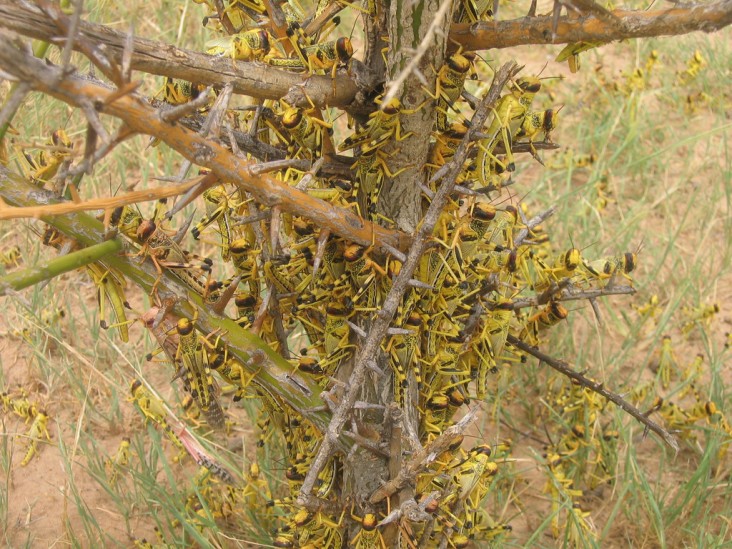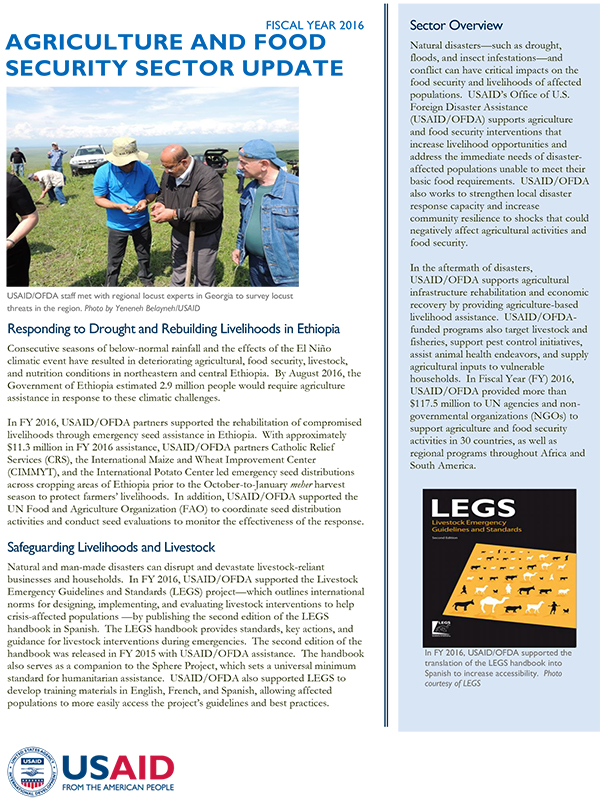- What We Do
- Agriculture and Food Security
- Democracy, Human Rights and Governance
- Economic Growth and Trade
- Education
- Ending Extreme Poverty
- Environment and Global Climate Change
- Gender Equality and Women's Empowerment
- Global Health
- Water and Sanitation
- Working in Crises and Conflict
- Disaster Assistance
- Political Transition Initiatives
- Conflict Mitigation and Prevention
- Countering Violent Extremism
- Disaster Risk Reduction
- Peacebuilding and Reconciliation
- Providing Safe & Secure Environments for Development
- Recovering From Crisis
- Resilience
- Tech Challenge for Atrocity Prevention
- World Humanitarian Day
- U.S. Global Development Lab

Transboundary outbreak pests (ETOPs), including locusts, grasshoppers, armyworm and rodents mean disaster for millions of people whose livelihoods depend on farming in several dozen countries around the world. The damage is more so in sub-Saharan Africa, Asia and Latin America. The desert locust alone threatens livelihoods of millions of people in more than 65 countries throughout Africa, the Middle East, and Southwest Asia. With the right ecological conditions, these insect pests can form dense swarms that quickly devour crops and pasture land, leaving people and animals without food to eat and pasture to graze. Farmers can see a year’s worth of work and sometimes sole means of supporting their families destroyed in moments.
Photo Gallery
Just as the weather can be forecast, USAID contends that favorable conditions for the proliferation of ETOPs can be predicted in advance. By working together with many international, national, regional and local organizations and partners, USAID is investing in monitoring, early warning, and early action to control locusts and other ETOPs and prevent them from causing massive damage to the livelihoods of vulnerable communities.
USAID created the Assistance for Emergency Locust/Grasshopper Abatement (AELGA) project in the late 1980s to deal with the plague of locusts and grasshoppers that affected much of Africa, the Middle East, and Southwest Asia over many years, and assist affected countries to prevent future major invasions. Formerly known as the Africa Emergency Locust/Grasshopper Assistance project, AELGA's overall objective is to help establish and strengthen national and regional capacities to prevent and control locusts, grasshoppers, and other ETOPs. ALEGA also strives to minimize and eliminate the adverse effects of pesticides to humans, their assets, to non-target and beneficial organisms as well as the environment.
Emergency Transboundary Outbreak Pests (ETOP)
FY 2017
ETOP update, September 2017 (474kb PDF)
ETOP update, August 2017 (469kb PDF)
ETOP update, July 2017 (776kb PDF)
ETOP update, June 2017 (661kb PDF)
ETOP update, May 2017 (122kb PDF)
ETOP update, April 2017 (630kb PDF)
ETOP update, March 2017 (323kb PDF)
ETOP update, February 2017 (731kb PDF)
ETOP update, January 2017 (245kb PDF)
ETOP update, December 2016 (764kb PDF)
ETOP update, November 2016 (366kb PDF)
ETOP update, October 2016 (199kb PDF)
FY 2016
ETOP update, September 2016 (263kb PDF)
ETOP update, August 2016 (433kb PDF)
ETOP update, July 2016 (754kb PDF)
ETOP update, June 2016 (463kb PDF)
ETOP update, May 2016 (885kb PDF)
ETOP update, April 2016 (329kb PDF)
ETOP update, March 2016 (254kb PDF)
ETOP update, February 2016 (259kb PDF)
ETOP update, January 2016 (192kb PDF)
ETOP update, December 2015 (124kb PDF)
ETOP update, November 2015 (474kb PDF)
ETOP update, October 2015 (382kb PDF)
FY 2015
ETOP update, September 2015 (1mb PDF)
ETOP update, August 2015 (791kb PDF)
ETOP update, July 2015 (1mb PDF)
ETOP update, June 2015 (773kb PDF)
ETOP update, May 2015 (602kb PDF)
ETOP update, April 2015 (697kb PDF)
ETOP update, March 2015 (381kb PDF)
ETOP update, February 2015 (116kb PDF)
ETOP update, January 2015 (211kb PDF)
ETOP update, December 2014 (217kb PDF)
ETOP update, November 2014 (93kb PDF)
ETOP update, October 2014 (846kb PDF)
Madagascar – Locusts
Madagascar locust update for the third dekad of May (93kb PDF)
Madagascar locust update for the second dekad of May (81kb PDF)
Madagascar locust update for the first dekad of May (86kb PDF)
Madagascar locust update for the first dekad of April (89kb PDF)
Madagascar locust update for the third dekad of February (15kb PDF)
Madagascar locust update for the second dekad of February (20kb PDF)
Madagascar locust update for the first dekad of February (15kb PDF)
Madagascar locust update for the third dekad of January (51kb PDF)









Comment
Make a general inquiry or suggest an improvement.